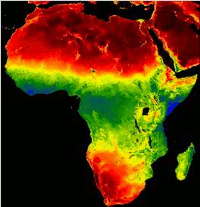The development of microinsurance products using satellite data to create index-based insurance products is a growing industry and one which is showing increasing promise as the pilot projects scale out to encompass thousands of policyholders. The application of satellite technologies to create indices against which insurance products can be triggered is changing the way farmers in Africa think about their businesses as they experience the benefits of risk transfer and insurance, often for the first time.
A high-tech, remote sensing company based in the Netherlands, EARS Earth Environment Monitoring, started a pilot called FESA Micro-insurance in 2009 aiming to develop low-cost, satellite based microinsurance to reach every farmer in Africa. They have developed both drought and excessive precipitation insurance using 30 years of Meteosat data which they collected and analysed.

Meteosat relative evapotranspiration (RE) drought insurance index
The 30 years of Meteosat hourly images were processed into 10 daily Relative Evapotranspiration (RE) and Cold Cloud Duration (CCD) data fields. These data fields serve as the basis for an insurance index of agricultural drought and excessive precipitation, respectively, giving the microinsurance products their indices against which trigger points can be set. The data sets cover the entire African continent at a resolution of 3 km meaning that the products can eventually be made available to everyone.
In 2012 the FESA Micro-insurance pilot has come a long way and the technology has reached considerable scale. They now have the potential scale and resources to insure several hundred thousands of farmers. This represents a major step towards affordable crop insurance for African farmers and will eventually help them to invest in better seed and fertilizer resulting in higher crop production and income as well as an ability to recover from the effects of weather and climate risks.
EARS said; “Increased food production requires African farmers to invest in better seeds, fertilizer and pesticides. In this way production and income may grow two or threefold. But most farmers don’t have the cash and need a loan for this purpose. MFI’s are reluctant to provide such loans, as crop failure due to drought or excessive precipitation would make redemption impossible. Micro-insurance is recognized as the key to this problem. It would enable African farmer to climb out of their poverty trap and start an upward spiral of increased income, savings and further investments.”
EARS use of satellite data enables micro weather index insurance to be rolled out across Africa, negating the need for a huge number of weather stations to be built to collect data locally. The parametric nature of the index triggers means that payouts are predictable and farmers understand that their claims will be dealt with swiftly.
As well as negating the need for local weather stations to be built, something which has always hindered weather insurance and weather derivatives in Africa, the use of satellite data is very low-cost per policyholder. EARS said that the yearly cost of data collection, index development and index monitoring is below 0.5 euro/farmer, so making up a very small part of the insurance premium.
As these index-based weather and climate insurance products scale out to include many thousands of policies, the need for sources of reinsurance will grow as well. There is an opportunity for forward thinking reinsurers and risk transfer providers to develop reinsurance alternatives which closely match the triggers of the underlying policies, thus utilising the same sources of data and saving costs on reinsurance cover as well. Could the capital markets become a source of capacity to support the microinsurance sector? It’s certainly possible and a well structured parametric catastrophe bond could be triggered based on the underlying satellite data. The challenge will be in educating investors that the underlying index is well understood, modelled and the attachment probabilities can be trusted.
We first wrote about the FESA microinsurance product back in 2010 here.
 View all of our Artemis Live video interviews and subscribe to our podcast.
View all of our Artemis Live video interviews and subscribe to our podcast.
All of our Artemis Live insurance-linked securities (ILS), catastrophe bonds and reinsurance video content and video interviews can be accessed online.
Our Artemis Live podcast can be subscribed to using the typical podcast services providers, including Apple, Google, Spotify and more.































